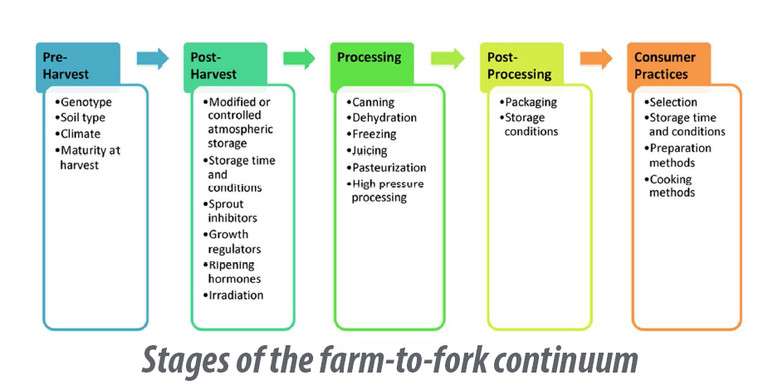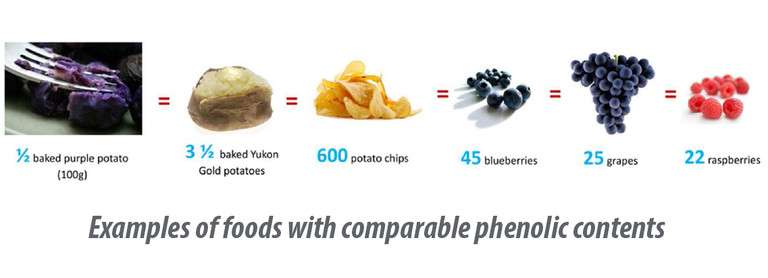Fruits, vegetables, 'farm-to-fork continuum' vital to cancer prevention

After decades of research aimed at improving the yield, appearance and safety of fruits, vegetables and grains, it's time to focus science on the health benefits those foods can provide, according to a cancer researcher in Penn State's College of Agricultural Sciences.
But concentrating on the foods' potential alone won't adequately assess their cancer-fighting properties, noted Jairam Vanamala, associate professor of food science. Instead, he contends that researchers must consider the effect of how foods are harvested, handled, stored and prepared to aid the development of new and science-based strategies for cancer prevention.
The influence of that "farm-to-fork continuum" on the bioactive compounds in fruits, vegetables and grains is critical and has largely gone unstudied, he believes.
Vanamala, also a faculty member of the Penn State Hershey Cancer Institute and the Center of Molecular Immunology and Infectious Disease, pointed out that new cancer cases are expected to surge 57 percent worldwide in the next two decades. With most cancers containing numerous genetic alterations and the dysregulation of multiple critical cellular-signaling pathways, he doesn't expect a "silver bullet" treatment effective against most cancers to emerge.
"Instead, research should shift toward developing prevention strategies for cancer. Accumulating evidence suggests that a diet high in plant-based foods is preventive of a variety of chronic diseases, including cancer," he said. "A plethora of bioactive compounds—such as polyphenols, glucosinolates and carotenoids in fruits, vegetables, grains and legumes—are shown to suppress a variety of biological capabilities required for tumor growth."

While much research has shown that plant bioactive compounds can suppress cancer growth and promote the demise of certain cancer cells, public health campaigns to increase fruit and vegetable consumption have been less effective than desired, Vanamala noted. In his article, "Food Systems Approach to Cancer Prevention," (which appeared in the journal Food Science and Nutrition), he calls for innovative strategies to support increased consumption of bioactive compounds for cancer prevention.
"Many practices in the farm-to-fork continuum, including preharvest methods, postharvest storage and processing, and consumer practices, affect a food's bioactive compound content, composition and chemopreventive bioactivity," Vanamala explained. "Food system practices may be adjusted to improve the bioactive compound profile, elevating the cancer-fighting properties of fruits, vegetables and other food products."
Ultimately, more systematic study of farm-to-fork effects on bioactive compounds will allow a greater understanding of the role of food in cancer prevention and will provide valuable information for use in many applications. More detailed research into how different farm-to-fork operations affect bioactive compounds could allow for strategic food system reform aimed at increasing the delivery of bioactive compounds and decreasing cancer incidence.
For example, Vanamala said, recent studies reported that two types of bioactive compounds—polyphenols and isothiocyanates—possess cancer preventive/protective activity. "These two compounds are present in many whole foods, such as grapes, broccoli and others. However, no studies have been conducted on using farm-to-fork-function continuum on whole foods anti-cancer activity even though pre- and postharvest practices were shown to alter the content and composition of bioactive compounds."
During the late 20th century, advancements in analytical techniques allowed for the improved isolation, quantification and characterization of bioactive compounds in foods, which then led to the study of single compounds in relation to cancer prevention, according to Vanamala. However, this silver-bullet approach could provide relatively few successes in terms of cancer-prevention strategies or treatments.
"As studies searching for an anti-cancer, pharmacologic effect from a single, individual bioactive compound have proved largely unsuccessful, the study of whole foods—of many functional groups working in concert—is more promising," he said. "Whole foods are complex mixtures of many bioactive compounds and other constituents, the synergy of which expresses 'polypharmacologic' effects. Thus, in the 21st century, research is focused on whole foods approaches/strategies to cancer prevention and treatment."
In this approach, whole foods are understood to contain many bioactive compounds, functional carbohydrates, healthy fats, vitamins, minerals and a correct energy balance, all acting in concert to prevent and treat cancer from multiple dimensions and molecular pathways.
Ironically, Vanamala suspects that the answer to finding more bioactive cancer protection from fruits, vegetables and grains may be found by looking back rather than ahead. He suspects that modern plant-breeding methods seem to have contributed to the loss of certain genetic material essential for the preservation of bioactive compounds, which has serious implications for public health and epidemiology, given the wide variation of bioactive compounds across crop cultivars.
"Despite these detrimental losses of biodiversity, the gene banks in many countries around the world have preserved genetic material for a variety of major crops. These resources could be utilized in the future for developing cultivars with better health promoting and disease preventing properties," he said.
"It is essential that more concentrated efforts be made by using modern genetic breeding techniques, not only to enhance the yield, sensory properties and safety of crops, but also to augment their content of health-benefiting bioactive compounds."
Ramping up the amount of bioactive, cancer-fighting compounds in foods via the farm-to-fork continuum is especially critical because the number of servings of fruits increased by only 0.3 and vegetables by only 0.8 per capita during the last 30 years. Given the ineffectiveness of public health campaigns to increase fruit and vegetable consumption, Vanamala said, selection of cultivars with greater bioactive compound content may be a more effective means of improving the overall health of the population.
But consumer selection has the greatest impact on overall dietary intake of bioactive compounds. Though crop biodiversity has decreased, consumers still have the ability to choose foods with more bioactive compounds in many situations.
"Choosing red onions, purple-fleshed potatoes, or even blue corn chips instead of their respective white alternatives could lead to increased bioactive compound intakes," Vanamala said.
"By selecting a wide variety of whole foods—consuming a rainbow of foods—consumers can maximize the health benefits gained from fruit and vegetable bioactive compounds."



















